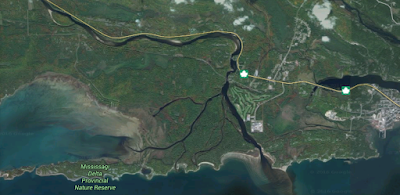May 9 – Here, a little ways past the town of Iron Bridge, my highway route runs right next to the Mississagi River. There’s nothing else in sight for miles, so I
decided to contemplate the river itself.
The Mississagi River meanders from lake to lake in
soggy Ontario. It begins in a small
unnamed lake in Sudbury District and flows into White Owl Lake, from which it
flows into Mississagi Lake. This must involve a lot of meltwater in the springtime.
The river then turns south and heads to Kettle Lake, the furthest point east it reaches, before continuing south and entering Mississagi River Provincial Park at Upper Bark Lake.
The river continues south, enters the large "L"-shaped Bark Lake, then heads west through Hellgate Rapids.
The Mississagi takes in a tributary, the Abinette River, then splits into two channels to form an island, recombines, and enters the large Rocky Island Lake, where another tributary, the Cypress River, enters. It then flows into Aubrey Lake, where the Wenebegon Rivers join it.
Even though much of the
water is funneled into a power station, some continues to flow over Aubrey
Falls.
 |
| A Snowy Owl in Flight, by David Hemmings |
The river then turns south and heads to Kettle Lake, the furthest point east it reaches, before continuing south and entering Mississagi River Provincial Park at Upper Bark Lake.
 |
| zigzag route to Hellgate Rapids |
The river continues south, enters the large "L"-shaped Bark Lake, then heads west through Hellgate Rapids.
 |
| Hellgate Rapids |
The Mississagi takes in a tributary, the Abinette River, then splits into two channels to form an island, recombines, and enters the large Rocky Island Lake, where another tributary, the Cypress River, enters. It then flows into Aubrey Lake, where the Wenebegon Rivers join it.
 |
| Aubrey Falls - spectacular beauty! |
The Mississagi turns south and a right tributary Aubinadong River enters, followed by two left tributaries, the Sharpsand River and the Rapid River in quick succession, and further on, another left tributary, Snowshoe Creek from Wakomata Lake.
 |
| Red Rock Generating Station |
 |
| bird's foot delta of the Mississagi River |
The Ojibwa people used the river to travel between the forests of the interior and Lake Huron. In 1799, the North West Company built a fur trading post at the mouth of the river. This post was closed in 1900.
 |
| logs ready to float to the sawmill |
This is a relatively short river with a lot of variety within its meandering course.
info: Wikipedia.com
maps: Google
Maps
Aubrey
Falls: http://waterfallsofontario.com/aubrey-falls.php
Red Rock
Station: https://brianlangis.wordpress.com/


No comments:
Post a Comment